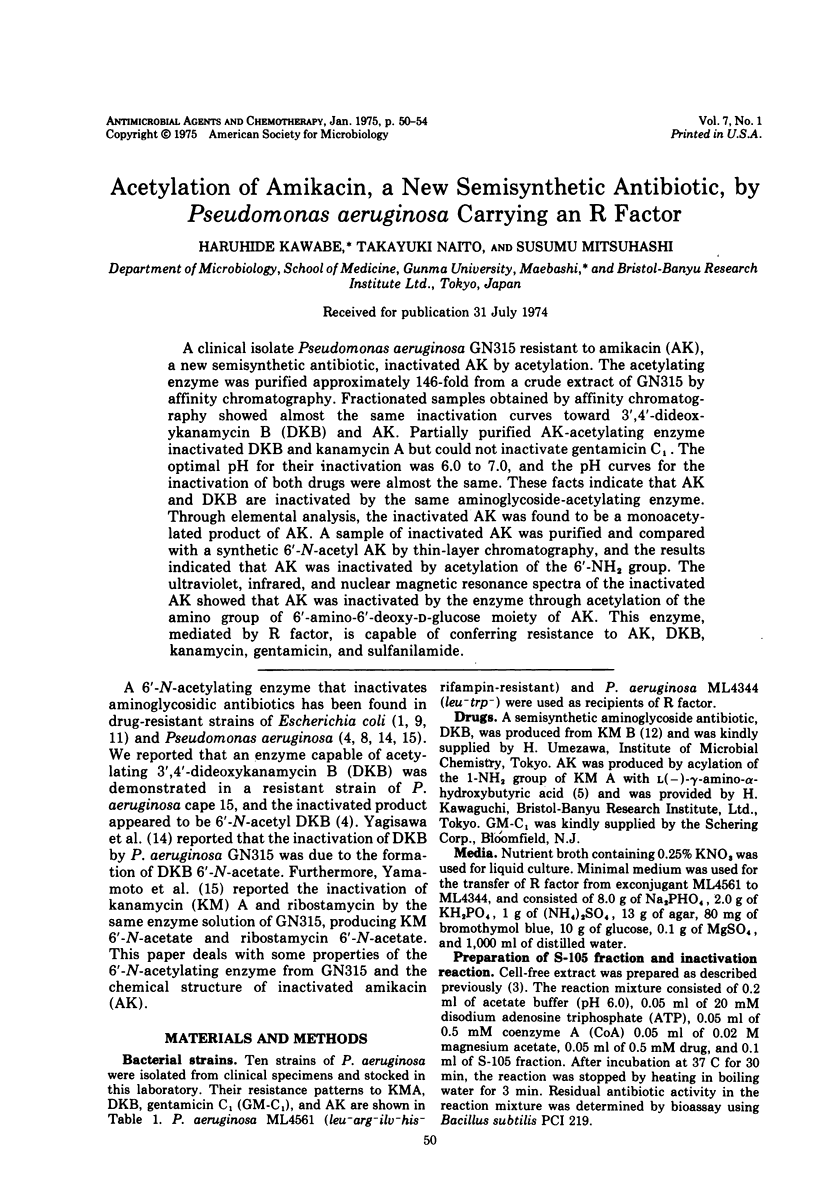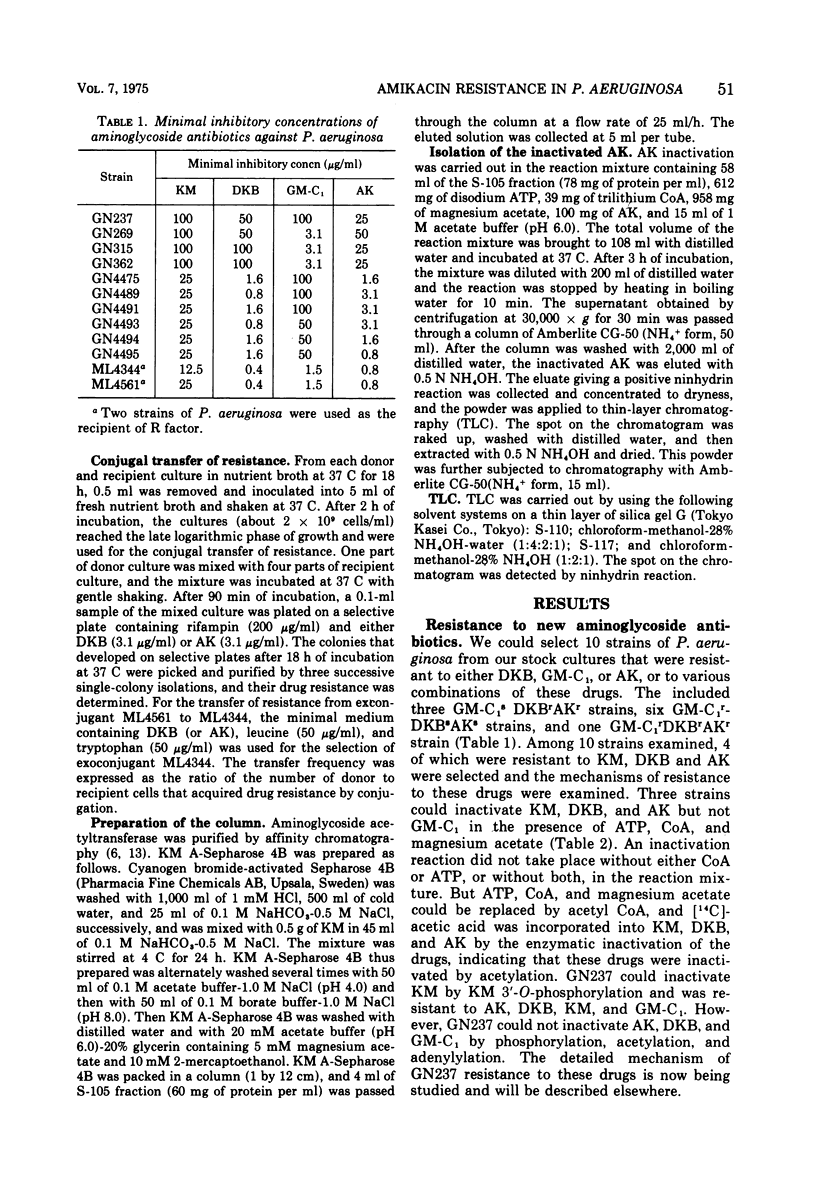Abstract
A clinical isolate Pseudomonas aeruginosa GN315 resistant to amikacin (AK), a new semisynthetic antibiotic, inactivated AK by acetylation. The acetylating enzyme was purified approximately 146-fold from a crude extract of GN315 by affinity chromatography. Fractionated samples obtained by affinity chromatography showed almost the same inactivation curves toward 3′,4′-dideoxykanamycin B (DKB) and AK. Partially purified AK-acetylating enzyme inactivated DKB and kanamycin A but could not inactivate gentamicin C1. The optimal pH for their inactivation was 6.0 to 7.0, and the pH curves for the inactivation of both drugs were almost the same. These facts indicate that AK and DKB are inactivated by the same aminoglycoside-acetylating enzyme. Through elemental analysis, the inactivated AK was found to be a monoacetylated product of AK. A sample of inactivated AK was purified and compared with a synthetic 6′-N-acetyl AK by thin-layer chromatography, and the results indicated that AK was inactivated by acetylation of the 6′-NH2 group. The ultraviolet, infrared, and nuclear magnetic resonance spectra of the inactivated AK showed that AK was inactivated by the enzyme through acetylation of the amino group of 6′-amino-6′-deoxy-d-glucose moiety of AK. This enzyme, mediated by R factor, is capable of conferring resistance to AK, DKB, kanamycin, gentamicin, and sulfanilamide.
Full text
PDF




Selected References
These references are in PubMed. This may not be the complete list of references from this article.
- Benveniste R., Davies J. Enzymatic acetylation of aminoglycoside antibiotics by Escherichia coli carrying an R factor. Biochemistry. 1971 May 11;10(10):1787–1796. doi: 10.1021/bi00786a009. [DOI] [PubMed] [Google Scholar]
- Benveniste R., Davies J. R-factor mediated gentamicin resistance: A new enzyme which modifies aminoglycoside antibiotics. FEBS Lett. 1971 May 20;14(5):293–296. doi: 10.1016/0014-5793(71)80282-x. [DOI] [PubMed] [Google Scholar]
- Kawabe H., Inoue M., Mitsuhashi S. Inactivation of dihydrostreptomycin and spectinomycin by Staphylococcus aureus. Antimicrob Agents Chemother. 1974 Jun;5(6):553–557. doi: 10.1128/aac.5.6.553. [DOI] [PMC free article] [PubMed] [Google Scholar]
- Kawabe H., Mitsuhashi S. Acetylation of dideoxykanamycin B by Pseudomonas aeruginosa. Jpn J Microbiol. 1972 Sep;16(5):436–437. doi: 10.1111/j.1348-0421.1972.tb00679.x. [DOI] [PubMed] [Google Scholar]
- Kawaguchi H., Naito T., Nakagawa S., Fujisawa K. I. BB-K 8, a new semisynthetic aminoglycoside antibiotic. J Antibiot (Tokyo) 1972 Dec;25(12):695–708. doi: 10.7164/antibiotics.25.695. [DOI] [PubMed] [Google Scholar]
- Le Goffic F., Moreau N. Purification by affinity chromatography of an enzyme involved in gentamicin inactivation. FEBS Lett. 1973 Feb 1;29(3):289–291. doi: 10.1016/0014-5793(73)80041-9. [DOI] [PubMed] [Google Scholar]
- Oara K., Kono M., Mitsuhashi S. Letter: Structure of enzymatically acetylated sisomicin by Pseudomonas aeruginosa. J Antibiot (Tokyo) 1974 May;27(5):349–351. doi: 10.7164/antibiotics.27.349. [DOI] [PubMed] [Google Scholar]
- Okanishi M., Kondo S., Suzuki Y., Okamoto S., Umezawa H. Studies on inactivation of kanamycin and resistances of E. coli. J Antibiot (Tokyo) 1967 Jul;20(3):132–135. [PubMed] [Google Scholar]
- Umezawa H., Okanishi M., Kondo S., Hamana K., Utahara R., Maeda K., Mitsuhashi S. Phosphorylative inactivation of aminoglycosidic antibiotics by Escherichia coli carrying R factor. Science. 1967 Sep 29;157(3796):1559–1561. [PubMed] [Google Scholar]
- Umezawa H., Okanishi M., Utahara R., Maeda K., Kondo S. Isolation and structure of kanamycin inactivated by a cell free system of kanamycin-resistant E. coli. J Antibiot (Tokyo) 1967 Jul;20(3):136–141. [PubMed] [Google Scholar]
- Umezawa H., Umezawa S., Tsuchiya T., Okazaki Y. 3',4'-dideoxy-kanamycin B active against kanamycin-resistant Escherichia coli and Pseudomonas aeruginosa. J Antibiot (Tokyo) 1971 Jul;24(7):485–487. doi: 10.7164/antibiotics.24.485. [DOI] [PubMed] [Google Scholar]
- Umezawa H., Yamamoto H., Yagisawa M., Kondo S., Takeuchi T. Letter: Kanamycin phosphotransferase. I. Mechanism of cross resistance between kanamycin and lividomycin. J Antibiot (Tokyo) 1973 Jul;26(7):407–411. doi: 10.7164/antibiotics.26.407. [DOI] [PubMed] [Google Scholar]
- Yagisawa M., Naganawa H., Kondo S., Takeuchi T., Umezawa H. 6'-N-acetylation of 3',4'-dideoxykanamycin B by an enzyme in a resistant strain of Pseudomonas aeruginosa. J Antibiot (Tokyo) 1972 Aug;25(8):495–496. doi: 10.7164/antibiotics.25.495. [DOI] [PubMed] [Google Scholar]
- Yamamoto H., Yagisawa M., Naganawa H., Kondo S., Takeuchi T. Kanamycin 6'-acetate and ribostamycin 6'-acetate, enzymatically inactivated products by Pseudomonas aeruginosa. J Antibiot (Tokyo) 1972 Dec;25(12):746–747. doi: 10.7164/antibiotics.25.746. [DOI] [PubMed] [Google Scholar]


